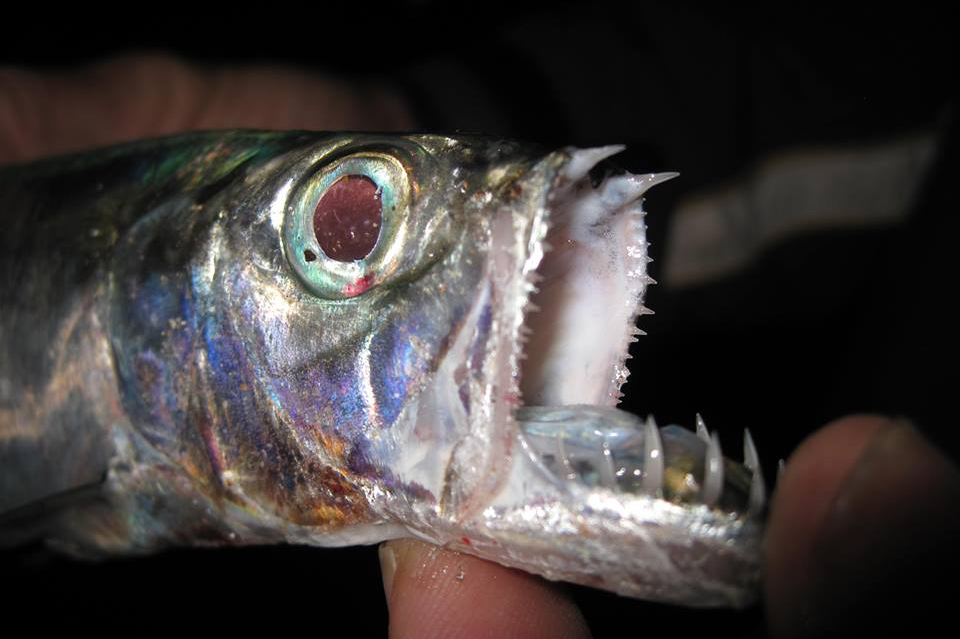Dorab Wolf Herring, Chirocentrus dorab (Forsskål 1775)
Other Names: Blackfin Wolf-herring, Dorab Wolf-herring, Knife-fish, Leaping Silver-bar, Ribbon-fish, Wolf Herring, Wolf-Herring

Dagger-like teeth of a Dorab Wolf Herring, Chirocentrus dorab, from Darwin - this one leapt into a boat at night. Source: Kate Buckley. License: All rights reserved
Summary:
A large voracious predator with many dagger-like teeth in the jaws. The Dorab Wolf Herring is elongate and very compressed, dark bluish-green above, bright silvery on the sides and below, with blackish outer dorsal-fin rays and blackish anterior anal-fin rays.
Dorab Wolf Herrings inhabit pelagic inshore waters where they prey on small baitfishes, sometimes in a feeding frenzy. They are attracted to lights at night and may suddenly leap from the water towards unwary boaters and anglers.
Dorab Wolf Herrings inhabit pelagic inshore waters where they prey on small baitfishes, sometimes in a feeding frenzy. They are attracted to lights at night and may suddenly leap from the water towards unwary boaters and anglers.
Cite this page as:
Dianne J. Bray, Chirocentrus dorab in Fishes of Australia, accessed 27 Jun 2025, https://fishesofaustralia.net.au/Home/species/2081
Dorab Wolf Herring, Chirocentrus dorab (Forsskål 1775)
More Info
|
Distribution |
Recorded in Australia from Shark Bay, WA, to Moreton Bay, QLD. Found elsewhere in warm coastal waters of the Indo-west Pacific, from the Red Sea to southern Japan, the Solomon Islands and Tonga. |
|
Features |
Meristic features: Dorsal fin 16–18; Anal fin 29–36; Pectoral fin 13–16; Pelvic fin 6; Gill rakers 1–4 + 10–16. Body elongate, strongly compressed, belly sharp, belly scutes absent; pectoral fin short, 11–13% SL. Head strongly compressed, mouth large, directed upward with two fang-like canine teeth pointing forward in the upper jaw, and a series of canine teeth in lower jaw, those at the front larger. Dorsal fin short-based, positioned well behind midpoint of body; pectoral fins low on body; pelvic fins very small; anal-fin base longer than dorsal, anterior rays positioned below dorsal fin origin; caudal fin deeply forked. Scales very small, cycloid - numerous and deciduous; lateral line absent. |
|
Feeding |
Carnivore - feeds mostly on small fishes including anchovies and herrings, but also on squids and crustaceans. |
|
Fisheries |
Targeted commercially in small numbers and as a sportsfish throughout most of its range. |
|
Species Citation |
Clupea dorab Forsskål, 1775, Descriptiones animalium: 72. Type locality: Jidda (as Djedda), Saudi Arabia and Mocha, Yemen, Red Sea |
|
Author |
Dianne J. Bray |
Dorab Wolf Herring, Chirocentrus dorab (Forsskål 1775)
References
Allen, G.R. 1997. Marine Fishes of Tropical Australia and South-east Asia. Perth : Western Australian Museum 292 pp. 106 pls.
Allen, G.R. & Swainston, R. 1988. The Marine Fishes of North-Western Australia. A field guide for anglers and divers. Perth, WA : Western Australian Museum vi 201 pp., 70 pls.
Forsskål, P. 1775. Descriptiones animalium avium, amphibiorum, piscium, insectorum, vermium; quae in itinere orientali observavit Petrus Forskål. Post mortem auctoris edidit Carsten Niebuhr. Adjuncta est materia medica kahirina atque tabula maris rubri geographica. Hauniae : Mölleri 1-20 + i-xxxiv + 1-164, 43, pls.
Gloerfelt-Tarp, T. & Kailola, P.J. 1984. Trawled Fishes of Southern Indonesia and Northwest Australia. Jakarta : Dir. Gen. Fish. (Indonesia), German Tech. Coop., Aust. Dev. Ass. Bur. 406 pp.
Grant, E.M. 1975. Guide to Fishes. Brisbane : Queensland Government, Co-ordinator General’s Department 640 pp.
Ishiguro, N. & K. Saitoh. 2007. Phylogenetic relationships among anchovies, sardines, herrings and their relatives (Clupeiformes), inferred from whole mitogenome sequences. Molecular Phylogenetics and Evolution 43: 1096–1105.
Johnson, J.W. 1999. Annotated checklist of the fishes of Moreton Bay, Queensland, Australia. Memoirs of the Queensland Museum 43(2): 709-762
Larson, H.K. & Williams, R.S. 1997. Darwin Harbour fishes: a survey and annotated checklist. pp. 339-380 in Hanley, H.R., Caswell, G., Megirian, D. & Larson, H.K. (eds). The Marine Flora and Fauna of Darwin Harbour, Northern Territory, Australia. Proceedings of the Sixth International Marine Biology Workshop. Darwin : Museum and Art Gallery of the Northern Territory 466 pp.
Luther, G. & S. Dharma Raja. 1982. Population Studies on the Fishes of the Genus Chirocentrus Cuvier. Journal of the Marine Biological Association of India 24 (1&2): 118-123.
Munroe, T.A., Nizinski, M.S. & Wongratana, T. 1999. Family Chirocentridae. pp. 1771-1774 in Carpenter, K.E. & Niem, V.H. (eds). The Living Marine Resources of the Western Central Pacific. FAO Species Identification Guide for Fisheries Purposes. Rome : FAO Vol. 3 pp. 1397-2068.
Paxton, J.R., Gates, J.E., & Bray, D.J. 2006. Chirocentridae. pp. 321-322 in Beesley, P.L. & Wells, A. (eds). Zoological Catalogue of Australia. Volume 35 Australia : ABRS & CSIRO Publishing Parts 1-3, 2178 pp.
Sainsbury, K.J., Kailola, P.J. & Leyland, G.G. 1985. Continental Shelf Fishes of Northern and North-Western Australia. Canberra : Fisheries Information Service 375 pp. figs & pls
Whitehead, P.J.P. 1985. FAO species catalog. Clupeoid fishes of the world (suborder Clupeoidei). Part 1 — Chirocentridae, Clupeidae and Pristigasteridae. FAO Fisheries Synopsis No. 125 Vol. 7 Pt 1. pp. 1-303
Whitehead, P. J. P. 1986. Family No. 56: Chirocentridae. pp. 207 in Smith, M.M. & Heemstra, P. (eds). Smith's Sea Fishes. Johannesburg : Macmillan South Africa xx + 1047 pp. 144 pls.






